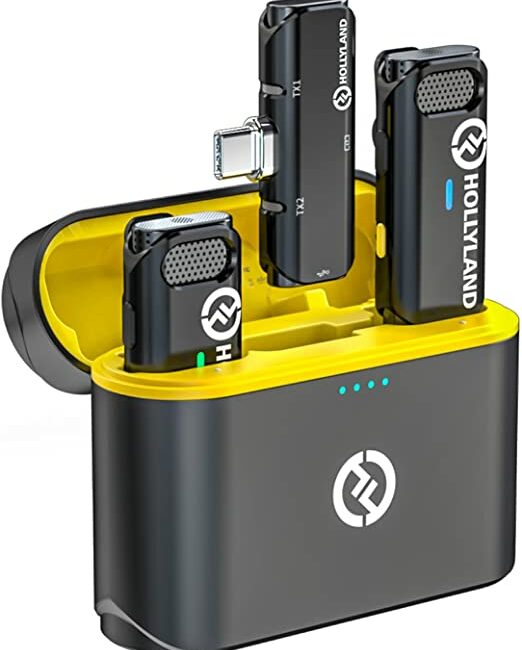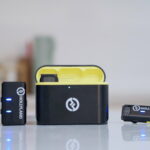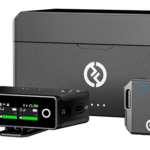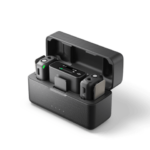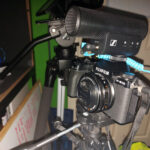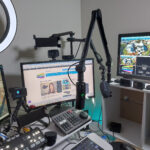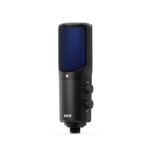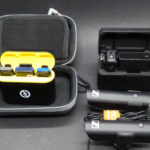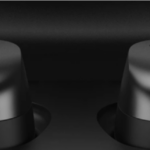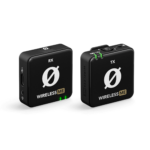I’ve looked at a few Hollyland products in the past – the Solidcom M1 system, Lark M1 wireless mic package and the MARS T1000 Comms System. I have been impressed by the quality of the products and their overall usability in general.
Yesterday I received the newest addition to the stable, the Lark C1 Wireless Mic kit.
Housed in a small case that doubles as a charger and battery, the Lark C1 components consist of a receiver unit that plugs into your smartphone or tablet and a pair of small clip-on wireless mics that come pre-paired.
There are a few permutations of the Lark C1 kit; you can get either Android (USB-C) or iOS (Lightning) versions and these can be either twin mic like I received, or single mic. There is also a range of colour schemes if that sort of thing is important to you. Mine came in black with yellow highlighting.
The unit comes most fully charged, and to top it up, simply plug in the supplied USB-C cable to the charge unit and connect it to a suitable USB port.
The receiver has a pair of LEDs – one for each mic – showing the current status of each (constant blue for connected and flashing blue for disconnected), and a single push button for pairing if required – the mics are pre-paired out of the box but if for some reason that pairing is broken, it only takes a couple of seconds to get them back and operational again.
The mics themselves are a bit more generous with controls having an on/off switch, status LED, a pairing button that doubles as a noise cancellation button and a USB-C charging port. The LED status is the same as the receiver with added ability to flash red when the battery is getting low and show green when noise cancellation is on.
Operation
I admit to being initially tricked as for the life of me, in the documentation I could not find out where the Lark C1 stored files it has recorded. My error was due to thinking it would work along the same lines as the Sennheiser Memory Mic.
But in fact, Hollyland has made it a lot simpler than that.
You see, the Lark C1 is just a mic system; it needs host software to record with. Depending on your device (and this includes some tablets and even Action cams such as the DJI Action 2 and 3) these apps and devices include the built-in camera, Voice Recorder (Android) TikTok, Facebook, Instagram and YouTube.
On the Hollyland website there is a complete table listing of all compatible phones and the apps that will work. Click here to go there.
Therefore, in use, it’s simply plug the receiver into your phone and wait about 2 seconds for it to be recognised, turn on the mics, wait under second and then start talking. I used the native Voice Recorder app on my Samsung A71 without a hitch. I also successfully tested it on a Samsung A7 tablet.
With the noise cancelling system, again, a simple approach has been taken. Noise cancelling is either off, weak or strong. In technical terms, when set to weak, noise will be reduced by -1db and when strong by -14dB.
The range is excellent too. I tried it from every room in the house with the phone / receiver in my office and it stayed connected every time. I then ventured outside with the full house between me and the unit and then went back another 20 metres with still with no loss.
Hollyland say you can get up to 200 metres range with line of sight which is more than adequate for most circumstances this system will be placed in.
Power
Each of the mics is said to work for up to 8 hours before a re-charge is needed, but Hollyland has put some thought into the receiver side, as with a pass-through USB-C port on it, you can also charge the receiver when it is use by simply plugging a cable from it to the charging station. And then of course you can also top up the mics as needed, saying during a break in recording. The specs say that all up, you may get up to 32 hours’ worth of recording out of a charge.
LarkSound App
I found the companion app called LarkSound – which you have to download from Play Store – to be a valuable adjunct. With this running, you can tell at a glance how much juice is left in the mics, what level noise cancellation value is set, the volume levels via a meter (and you can increase or decrease the volume) and whether the audio is to played on the device’s speaker whilst recording.
You can also get the serial number of each component here, which you do need should you ever have to contact Hollyland Tech Support.
Conclusion
If you do a lot of smartphone audio recording and feel you need better quality audio as well as far more flexibility, then you are exactly the market the Hollyland Lark C1 aimed at.
Sound quality is excellent, you have the choice of your own app / device to record with, the wireless range is more than adequate for most uses and the price, at AUD$315 from Amazon Australia, is not a budget buster. If you want seriously good audio for your vlogging, podcast, small / short film production or other projects where a simple but very effective system is needed then the Hollyland Lark C1 is worth your consideration.

